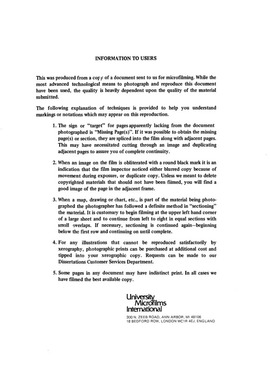| dc.contributor.author | Martin, Ann, | en_US |
| dc.date.accessioned | 2013-08-16T12:28:13Z | |
| dc.date.available | 2013-08-16T12:28:13Z | |
| dc.date.issued | 1980 | en_US |
| dc.identifier.uri | https://hdl.handle.net/11244/4776 | |
| dc.description.abstract | The problem of reducing mathematics anxiety in students needs further attention. The need exists for methods to alleviate anxiety that can be used in the classroom by the instructor. This study of the effect of the calculator is one attempt in this direction. | en_US |
| dc.description.abstract | The primary purpose of this study was to investigate the effect of the calculator on the mathematics anxiety of college algebra students. Five null hypotheses were tested. There is no significant difference: (1) in mathematics anxiety between college algebra students who use a calculator and those who do not; (2) in mathematics anxiety between male and female college algebra students; (3) in the effect of the calculator on mathematics anxiety between male and female college algebra students; (4) in mathematics anxiety between college algebra students enrolled in day classes and those enrolled in evening classes; and (5) in the effect of the calculator on mathematics anxiety between day and evening college algebra students. | en_US |
| dc.description.abstract | This study suggests that for this sample the calculator alone does not affect mathematics anxiety in college algebra students. However, the combination of the calculator, the college algebra course itself, and other in-class and out-of-class activities does reduce mathematics anxiety. These conclusions follow from the fact that when a t test was computed using the calculator groups pretest and post-test scores, a significant reduction in mathematics anxiety was experienced. The non-calculator group had a nonsignificant reduction in mathematics anxiety. When the two groups' reductions were compared to each other by the analysis of variance, no significant difference was found between the two reductions. | en_US |
| dc.description.abstract | The pretest MARS scores were analyzed with regard to group (control and experimental), gender (male and female), and time of class (day and evening) by computing a three-way analysis of variance. The differences in pretest and post-test MARS scores were analyzed with regard to the same categories by another analysis of variance. At the .05 level of significance only one hypothesis was rejected--hypothesis 4. Besides the results of this study showing that hypothesis 4 should be rejected, the study showed that the mean score of the evening students was higher than that of day students. This indicates that students enrolled in evening classes of college algebra have higher mathematics anxiety levels than students in day classes. | en_US |
| dc.description.abstract | In order to investigate these hypotheses, the college algebra classes during the spring semester, 1980, at South Oklahoma City Junior College, Oklahoma City, Oklahoma, were separated into a control group and an experimental group. The experimental group used calculators in class for concept formation and computation. The control group did not use calculators in class. Both groups completed Suinn's Mathematics Anxiety Rating Scale (MARS) at the beginning of the semester and at the end of the seven-week experimental period. | en_US |
| dc.format.extent | v, 51 leaves ; | en_US |
| dc.subject | Education, Mathematics. | en_US |
| dc.title | The effect of the use of the calculator on mathematics anxiety in college algebra students. | en_US |
| dc.type | Thesis | en_US |
| dc.thesis.degree | Ph.D. | en_US |
| dc.thesis.degreeDiscipline | Department of Mathematics | en_US |
| dc.note | Source: Dissertation Abstracts International, Volume: 41-06, Section: A, page: 2485. | en_US |
| ou.identifier | (UMI)AAI8027524 | en_US |
| ou.group | College of Arts and Sciences::Department of Mathematics | |
